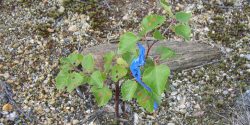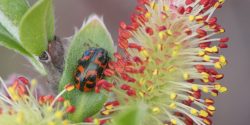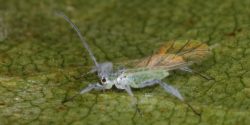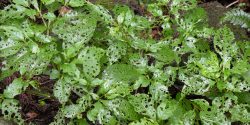Past research
The main study systems of my team are the polymorphic leaf beetle, Chrysomela lapponica, and its host plants (willows and poplar), and several leaf-mining and leaf-rolling species of moths that feed on birches. We demonstrated that industrial pollution favours some plant-feeding insects via changes in host-plant architecture and by decreases in the predation or parasitism rates, and that minor local damage to plant leaves can cause their premature abscission and trigger delayed local responses. The most recent findings concern the evolution of chemical defences in herbivorous insects and the impacts of the engineering activity of moth larvae on litter decomposition rates.
Ongoing research
We are presently analysing the outcomes of a long-term, large-scale defoliation experiment aimed at exploring the impacts of climate on responses of boreal trees to background insect herbivory. We are also collecting published data to analyse the geographical patterns of the losses of root biomass to insects and the patterns of predation and parasitism rates of leaf-feeding insects across the globe. An ongoing field experiment addresses the impacts of leaf engineering activity (tying or rolling) of moth larvae on damage to leaves by externally feeding defoliators.
Featured publications
Zverev, V., Zvereva, E. L., & Kozlov, M. V. (2020) Bird predation does not explain spatial variation in insect herbivory in a forest-tundra ecotone. Polar Biology, 43, 295–304 (doi: 10.1007/s00300-020-02633-2).
Bird attacks on artificial caterpillars were tenfold more frequent in forest than in tundra, while bird exclusion effects on herbivory did not differ between these habitats. Bird exclusion led to increases in insect herbivory in trees and tall shrubs but not in dwarf shrubs. Bird predation, as measured in bird exclusion experiments, increased with an increase in the level of foliar damage inflicted by insects in forests but not in tundra habitats. We conclude that birds are unlikely to shape the spatial patterns of plant losses to insects in Arctic ecosystems.
Shestakov, A. L., Filippov, B. Yu., Zubrii, N. A., Klemola, T., Zezin, I., Zverev, V., Zvereva, E. L., & Kozlov, M. V. (2020) Doubling of biomass production in European boreal forest trees by a four-year suppression of background insect herbivory. Forest Ecology and Management, 462, 117992 (doi: 10.1016/j.foreco.2020.117992).
In boreal taiga forests near Arkhangelsk (Northern Russia), application of insecticide at 10-day intervals for four growth seasons (June–September of 2014–2017) decreased foliage losses to insects in our study species (early successional deciduous Betula pubescens and Populus tremula; late successional coniferous Picea abies and Pinus sylvestris) from 2.04–6.35% to 0.72–1.18%. Across all tree species, insecticide treatment nearly doubled the increase in tree biomass relative to control plots, demonstrating that background insect herbivory has major negative impacts on tree growth and productivity. In addition, decrease in insect herbivory enhanced competitiveness of early successional trees.
Zvereva, E. L., Paolucci, L. N., & Kozlov, M. V. (2020) Top-down factors contribute to differences in insect herbivory between saplings and mature trees in boreal and tropical forests. Oecologia, 193, 167–176 (doi: 10.1007/s00442-020-04659-z).
Leaf area losses to chewing insects in saplings were 2.5-fold higher than in mature trees in both Siparuna guianensis in Brazil and Betula pubescens in Finland. Overall, predation rates on model prey were consistently higher on mature trees than on saplings at both sites; but in the boreal site, this pattern was primarily driven by birds, whereas in the tropical site, it was primarily driven by arthropod predators. We conclude that the effect of predation on herbivorous insects may considerably contribute to ontogenetic differences in herbivory.
Zvereva, E. L. & Kozlov, M. V. (2016) The costs and effectiveness of chemical defenses in herbivorous insects: a meta-analysis. Ecological Monographs, 86, 107-124 (doi: 10.1890/15-0911.1).
We tested several hypotheses about the evolution of chemical defenses in plant-feeding insects using a meta-analysis of the effectiveness and costs of chemical defenses in various prey–predator systems (140 herbivore species and 124 enemy species). These defenses, on average, were effective against generalist predators, but increased the risk of parasitism. We found no physiological costs of the production of chemical defenses. We conclude that the cost–benefit trade-offs are affected by ecological costs (i.e., increased susceptibility to parasitoids) more than by costs in terms of resources.
Zvereva, E. L., Kozlov, M. V. & Rank, N. E. (2016) Does leaf beetle specialization on toxic host plants protect them from ants? Biological Journal of the Linnean Society, 119, 201–212 (doi: 10.1111/bij.12801).
We tested the hypothesis that predators may favour specialization of herbivores on host plants containing toxic chemicals. We found that ants were more strongly repelled by leaf beetle larvae with host plant-derived, salicylaldehyde-containing secretions than by larvae with various autogenous secretions, but collectively foraging of ants in the vicinity of their nests ultimately overcame any type of chemical defence. We conclude that evolutionary shifts from autogenous production of secretion to sequestration of plant allelochemicals in leaf beetles may be favoured mostly at low ant densities on the periphery of ant foraging areas.
Kozlov, M. V., Zverev, V. & Zvereva, E. L. (2016) Shelters of leaf-tying herbivores decompose faster than untied leaves damaged by free-living insects. Science of the Total Environment (published online; doi: 10.1016/j.scitotenv.2016.04.121).
We hypothesized that the decomposition rate is faster for shelters of leaf-tying larvae than for leaves damaged by free-living insects, in particular due to the accumulation of larval frass within shelters. We found that while leaf damage by insects per se reduces litter quality and its decomposition rate, structuring of litter by leaf-tying insects counterbalances these negative effects. We conclude that leaf-tying larvae, in contrast to free-living defoliators, do not impose negative effects on nutrient turnover rate even at their high densities, which are frequently observed in heavily polluted sites.
Kozlov, M. V., Lanta, V., Zverev, V. E. & Zvereva, E. L. (2012) Delayed local responses of downy birch to damage by leafminers and leafrollers. Oikos, 121, 428-434 (DOI: 10.1111/j.1600-0706.2011.19625.x).
We demonstrated delayed local compensatory growth and increased antiherbivore defence in downy birch shoots following local injuries by several leafmining and leafrolling insects. We suggest that this pattern reflects evolutionary adaptations of plants to permanently acting minor, dispersed and spatially unpredictable damage imposed by endemic herbivory. Local responses are less costly and represent a more sustainable strategy to maintain plant fitness under low levels of herbivory than constitutive resistance or systemic responses.
Co-authors
B. Yu. Filippov
E. Haukioja
T. Klemola
J. Koricheva
V. Lanta
P. Niemelä
L. N. Paolucci
N. E. Rank
A. L. Shestakov
I. Zezin
N. A. Zubrii
E. Zvereva
V. Zverev
Co-operating scientists
B. Castagneyrol
L. Cayuela
A. Exnerova
A. Forsman
L. Garibaldi
N. Salinas
Funding
Academy of Finland
Maj and Tor Nessling Foundation



